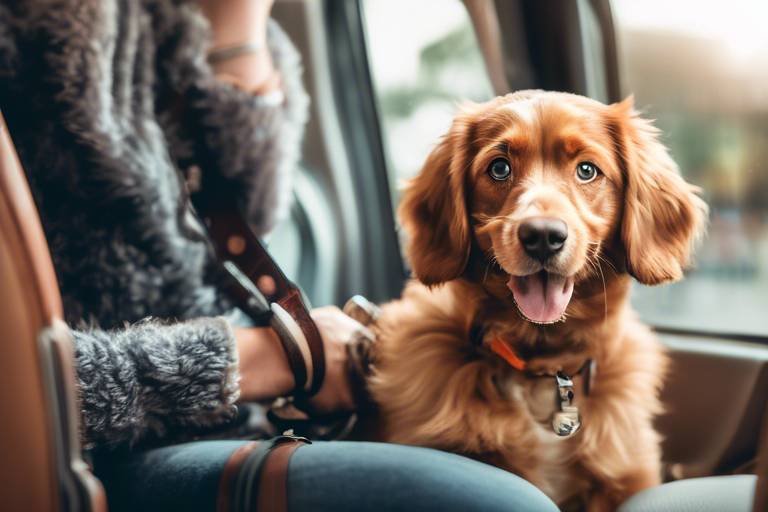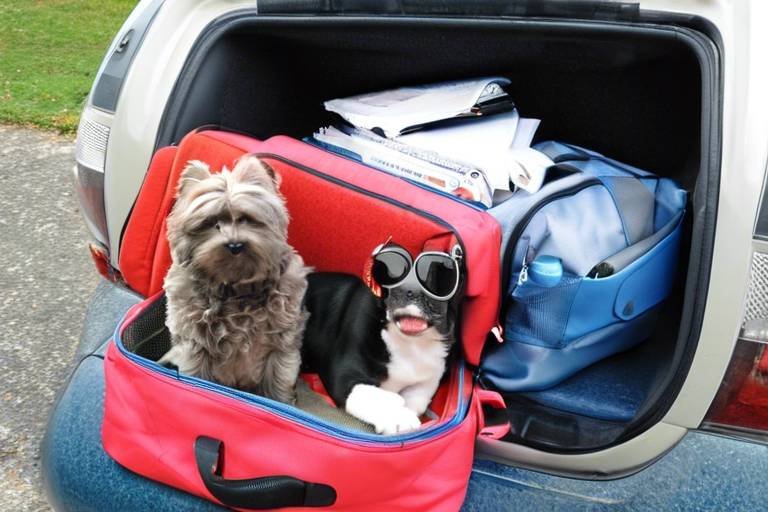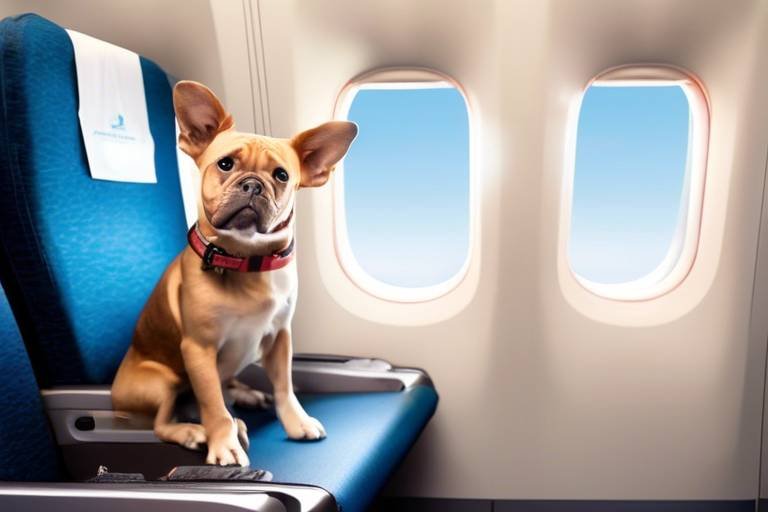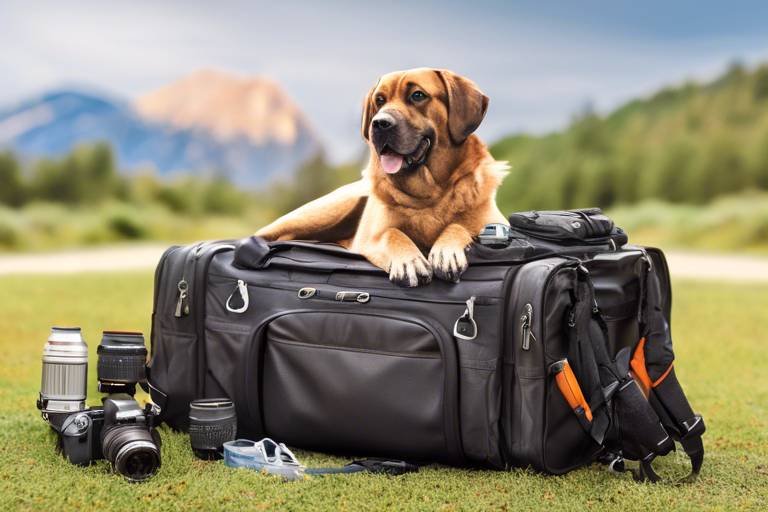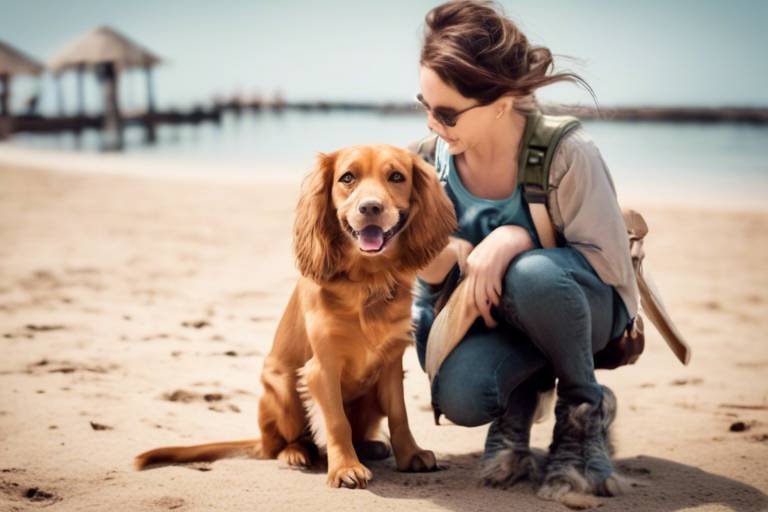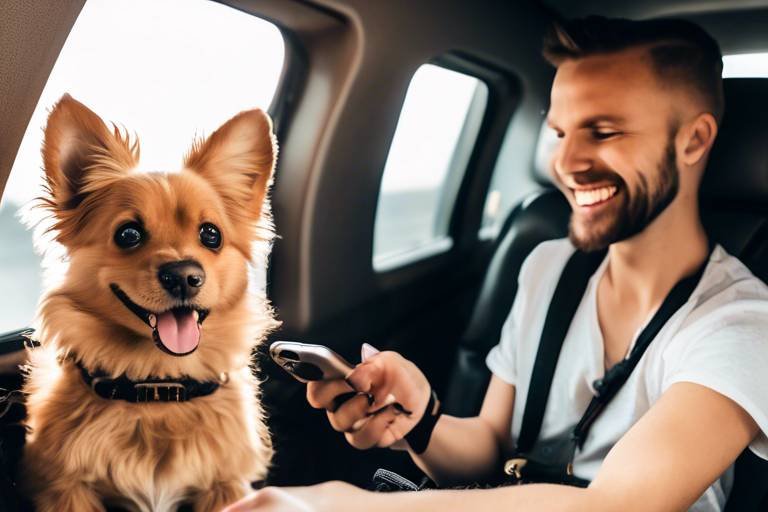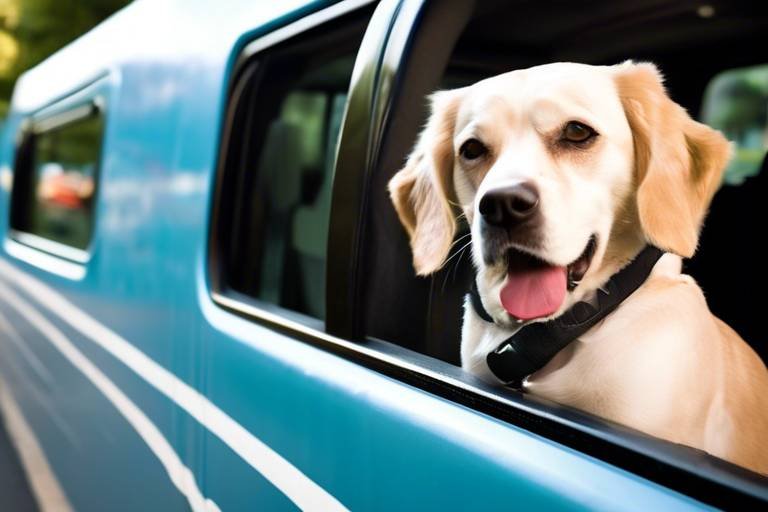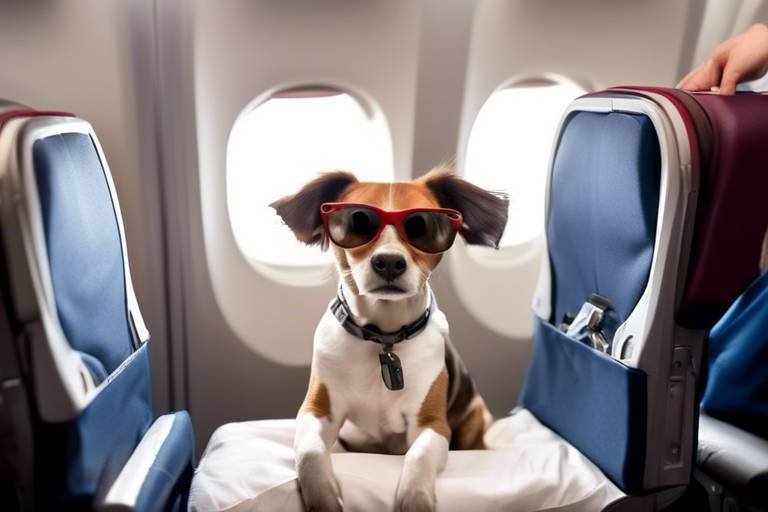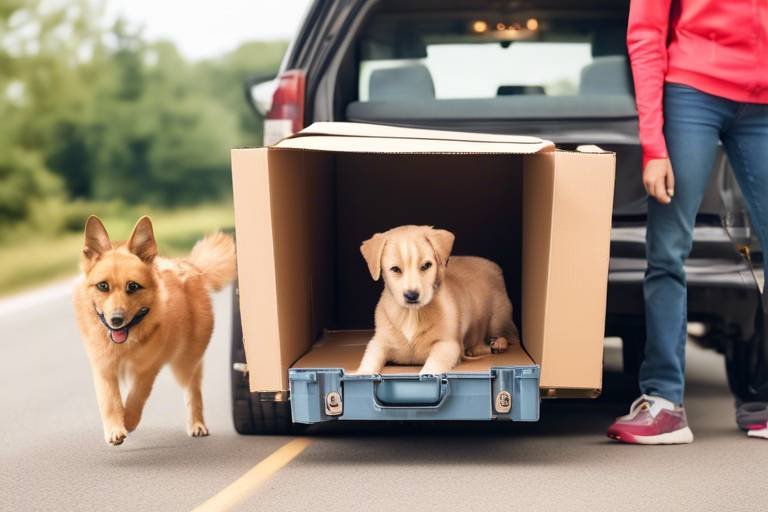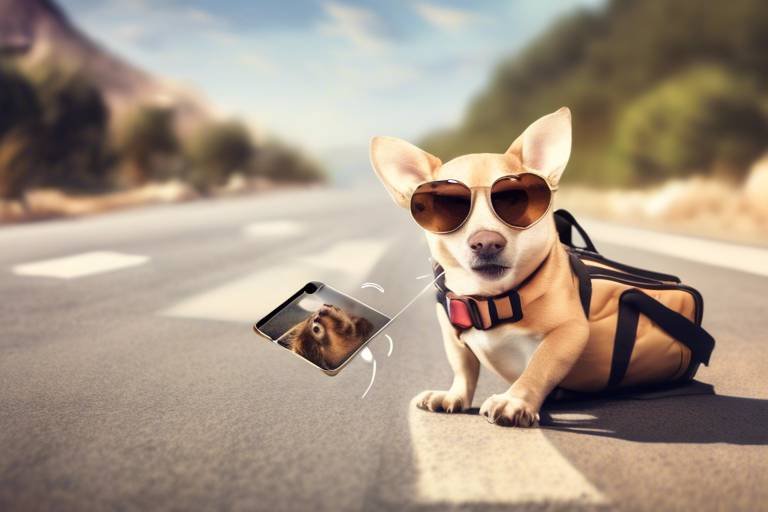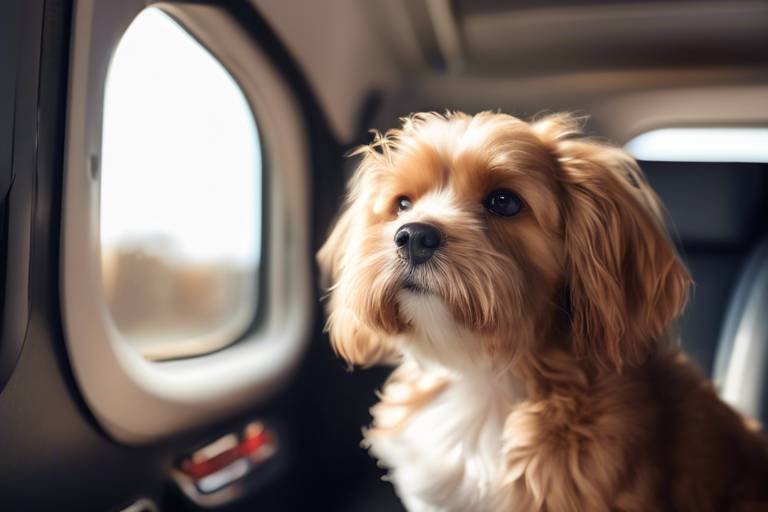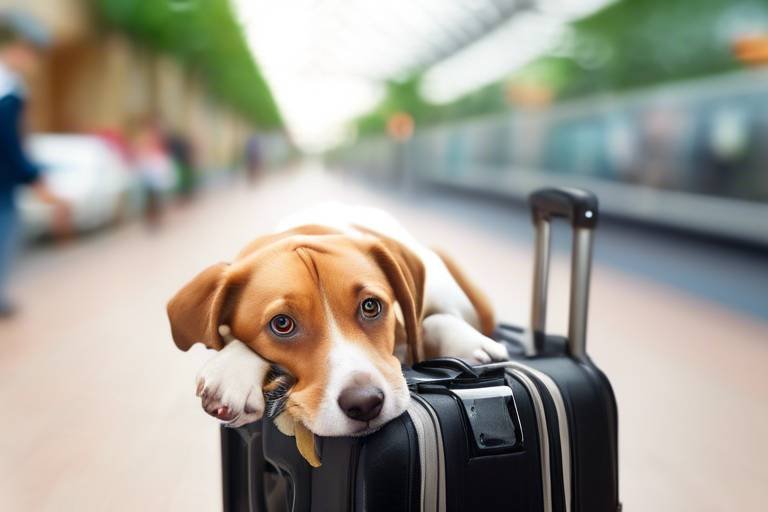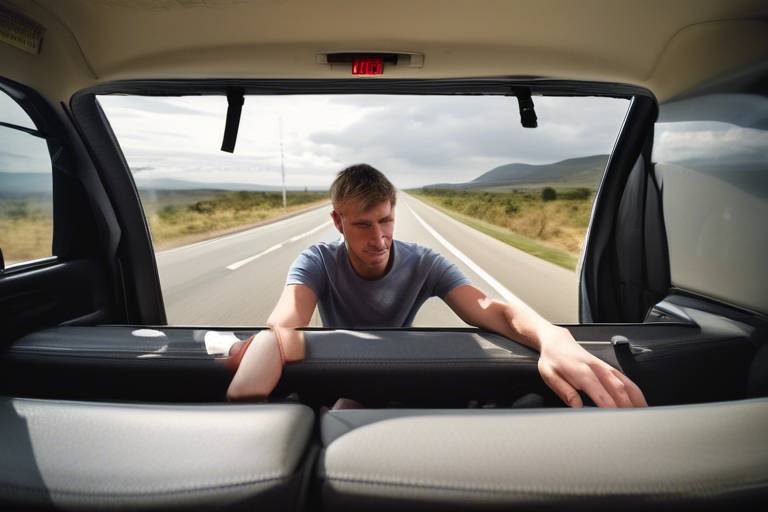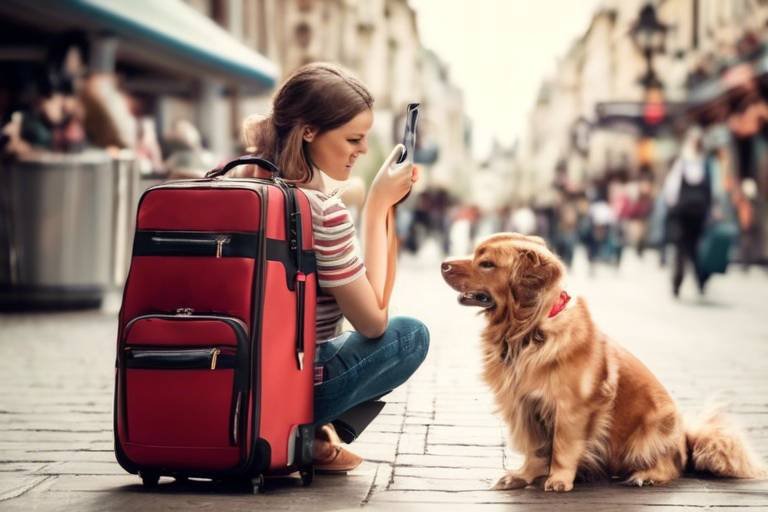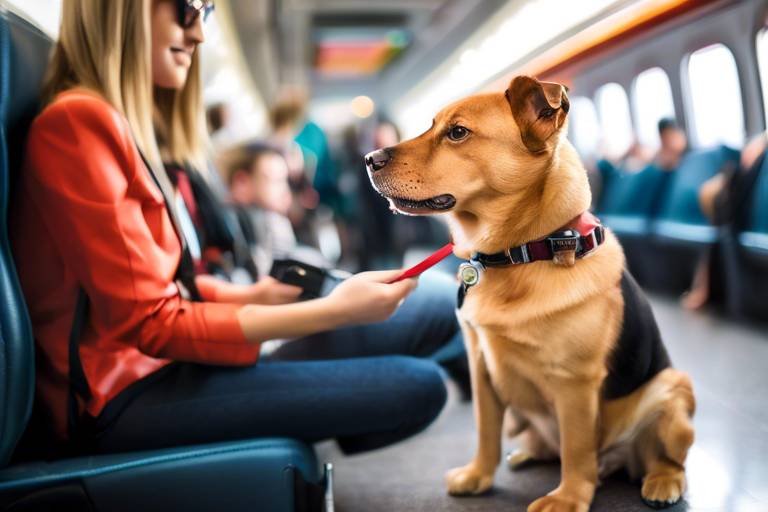The Dos and Don’ts of Traveling with Dogs
Traveling with your furry friend can be one of the most rewarding experiences, but it also comes with its own set of challenges. Whether you're embarking on a road trip or flying to a new destination, understanding the dos and don'ts of traveling with dogs can make all the difference. Imagine the joy of exploring new places with your four-legged companion by your side, but also picture the chaos that can ensue if things aren't planned properly. This article dives into essential tips for pet owners, highlighting best practices and common pitfalls to ensure a safe and enjoyable journey for both you and your beloved pooch.
Planning your trip in advance is crucial when traveling with dogs. This means doing your homework on pet-friendly accommodations, understanding travel regulations, and preparing for your dog's specific needs during the journey. For instance, if you're driving, consider the duration of your trip and plan for regular breaks to let your dog stretch their legs. If you're flying, check the airline’s pet policies and book a direct flight whenever possible to minimize stress. Also, don’t forget to pack a travel bag for your dog that includes their favorite toys, food, and any necessary medications. Remember, a well-prepared trip is a happy trip!
Always ensure your dog has proper identification. This includes a collar with tags that have your contact information and a microchip. In the event that your dog gets lost, having these forms of identification is vital for their safety and increases the chances of being reunited. It's a simple yet effective way to ensure peace of mind while you're on the road. Think of it as a safety net; you hope you won't need it, but it’s always better to be prepared.
Having a first aid kit specifically for your dog can be a lifesaver. It should include necessary medications, bandages, and other supplies to address minor injuries or health issues on the road. You might be wondering what exactly to include in this kit. Here's a quick rundown:
- Adhesive bandages
- Gauze pads and tape
- Antiseptic wipes
- Dog-safe pain relievers (consult your vet first)
- Any prescribed medications
Being prepared for unexpected situations can help you stay calm and focused, ensuring your dog's well-being throughout the trip.
Leaving your dog unattended in a vehicle can be dangerous. Temperatures can rise quickly, leading to heatstroke, and your dog may also become anxious or destructive if left alone for too long. If you must stop somewhere, consider taking your dog with you or making arrangements for pet-friendly services. Remember, your dog is not just a pet; they are a family member, and their safety should always come first!
Dogs thrive on routine, so try to maintain their feeding, walking, and sleeping schedules as closely as possible. This helps reduce anxiety and keeps them comfortable while traveling. Think of it as keeping a steady beat in a song; when the rhythm is consistent, everything flows better. If you usually walk your dog in the morning, try to stick to that routine even while traveling. Consistency is key!
While it’s important to bring essentials, avoid overpacking for your dog. Focus on the basics like food, water, bowls, and favorite toys to ensure a stress-free travel experience. Just like you wouldn’t want to lug around a heavy suitcase filled with unnecessary items, your dog doesn’t want to be weighed down by an overflowing travel bag. Keep it simple and efficient!
Understanding your dog's temperament is key to a successful trip. Some dogs may be more adaptable to travel, while others may require extra care and attention during the journey. For example, if your dog is naturally anxious, you might want to bring along familiar items like their blanket or favorite toy to make them feel more at home. Conversely, if your dog is adventurous and loves new experiences, consider planning activities that cater to their energetic spirit. Tailoring your approach based on your dog’s personality can lead to a much more enjoyable experience for both of you.
Be vigilant for signs of stress in your dog, such as excessive barking, panting, or pacing. Addressing these signs promptly can help prevent further anxiety and ensure a more pleasant travel experience. If you notice your dog becoming restless, take a break and allow them to stretch their legs or explore a new area. Think of your dog as a sensitive barometer; they can pick up on the atmosphere around them, and it's essential to keep their emotional well-being in check.
Q: What should I do if my dog gets car sick?
A: If your dog is prone to car sickness, consult your veterinarian for advice. They may recommend medications or suggest that you gradually acclimate your dog to longer car rides.
Q: Can I take my dog on a plane?
A: Yes, many airlines allow pets to travel in the cabin or as cargo. Always check the airline's specific pet policy and book in advance.
Q: How can I keep my dog calm during travel?
A: Keeping your dog calm can be achieved through familiar items, regular breaks, and maintaining their routine as much as possible. Consider using calming aids if necessary, but consult your vet first.
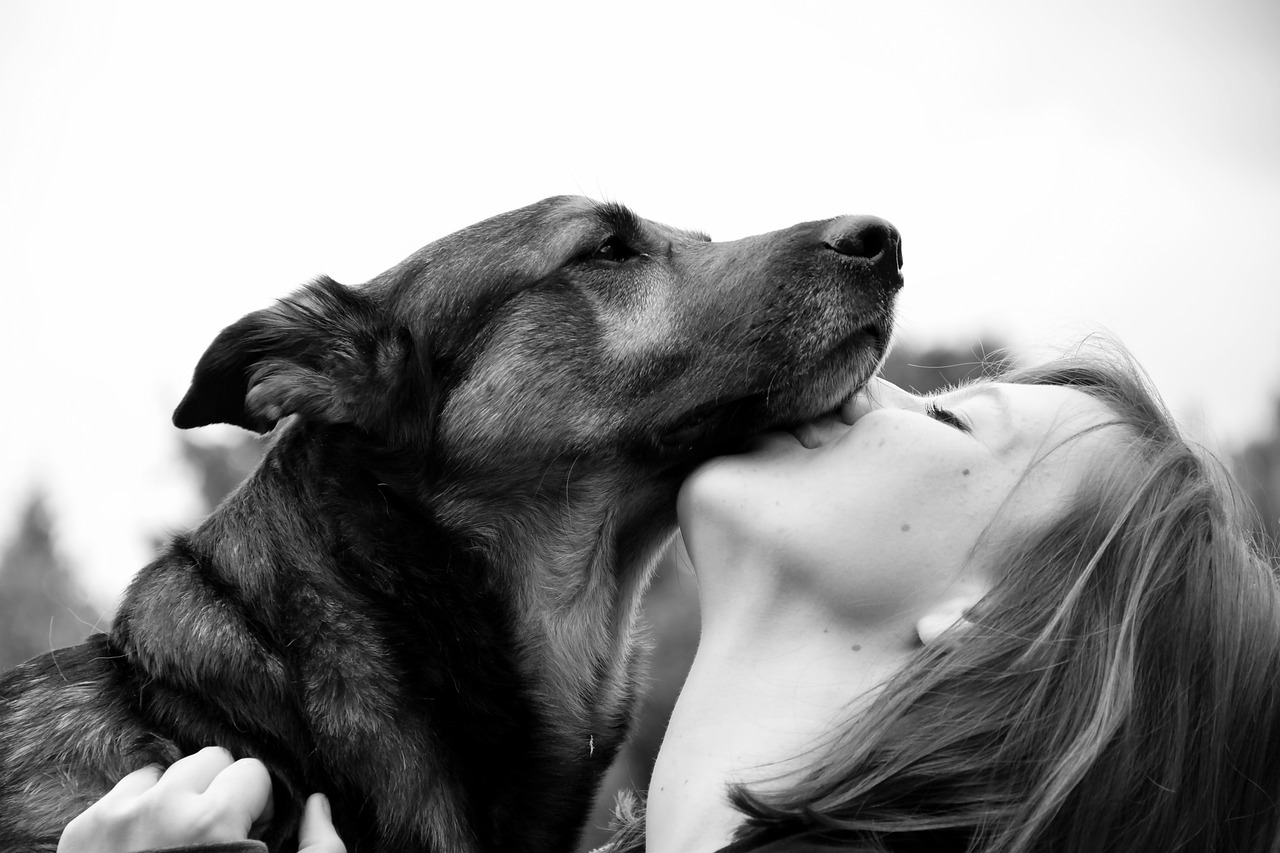
Do Plan Ahead
When it comes to traveling with your furry companion, planning ahead is not just a suggestion—it's a necessity! Imagine embarking on a road trip with your dog, only to find out that your chosen hotel doesn’t allow pets. What a bummer, right? To avoid such hiccups, it's essential to do your homework before hitting the road. Start by researching pet-friendly accommodations. Websites like BringFido or Airbnb can be lifesavers in this scenario, offering plenty of options that welcome your four-legged friends. Additionally, don’t forget to check the travel regulations of your destination. Some places have specific rules regarding dogs, including leash laws and vaccination requirements. Knowing these details in advance can save you from unexpected fines or, worse, having to leave your dog behind.
Another crucial aspect of planning is understanding your dog’s specific needs. Each dog is unique, and what works for one might not work for another. For instance, if your dog is prone to anxiety during travel, consider bringing along their favorite blanket or toy to provide comfort. Also, plan for regular breaks during long drives to let your dog stretch their legs and relieve themselves. You wouldn’t want to be cooped up in a car for hours on end, so why should your dog? Make sure to schedule these stops into your travel itinerary.
Lastly, packing the right gear is part of your planning process. Here’s a quick checklist of essentials you might want to include:
- Food and water
- Bowls for feeding
- Leash and harness
- Dog bed or blanket
- First aid kit
- Favorite toys
By taking the time to plan ahead, you not only ensure a smoother journey but also make the experience enjoyable for both you and your dog. After all, a well-prepared trip can turn potential stress into a memorable adventure!

Don't Forget Identification
When embarking on an adventure with your beloved canine companion, one of the most critical aspects of preparation is ensuring that your dog has proper identification. Imagine the heart-wrenching scenario of losing your furry friend in a bustling new environment. Without adequate identification, the chances of a happy reunion diminish significantly. Therefore, it's essential to equip your dog with a collar that includes a tag displaying your contact information. This tag should ideally contain your name, phone number, and possibly even your home address. In addition to the collar, consider having your dog microchipped. This small device, implanted just under the skin, carries a unique identification number that can be scanned by veterinary clinics and shelters, making it easier to reunite you with your pet should they wander off.
Furthermore, it’s wise to keep a recent photo of your dog on your phone. This can be invaluable if you need to post about a lost pet on social media or alert local shelters. In your photo, capture your dog in a clear setting, showcasing any unique markings or characteristics that make them stand out. This will help others recognize your dog more easily. Remember, preparation is key, and taking these simple steps can provide peace of mind throughout your travels.
In case of emergencies, having a comprehensive identification plan can make all the difference. Here are a few additional tips to ensure your dog is always identifiable:
- Update Information: Regularly check that the information on your dog's tags and microchip is up-to-date, especially if you’ve moved or changed phone numbers.
- Use a Breakaway Collar: Consider using a breakaway collar that allows your dog to escape if they get caught on something, minimizing the risk of injury while still keeping the ID secure.
- Consider GPS Tracking: For extra security, think about investing in a GPS collar. This technology allows you to track your dog’s location in real-time through a smartphone app.
Ultimately, the safety and well-being of your dog should always come first. By ensuring they have proper identification, you’re not just following a guideline; you’re taking a proactive approach to their safety. So, before you hit the road, double-check that your furry friend is equipped with everything they need to be easily identifiable!
Do Keep a First Aid Kit
When it comes to traveling with your furry companion, being prepared for the unexpected is key. A first aid kit specifically designed for your dog can be a true lifesaver. Imagine this: you're on a beautiful hiking trail, the sun is shining, and your dog is happily exploring. Suddenly, they get a thorn in their paw or a scrape on their leg. Having a first aid kit handy means you can quickly address these minor injuries and keep the fun going!
So, what should you include in this essential kit? First and foremost, make sure to have a supply of bandages in various sizes. These can help cover wounds and prevent infection. Additionally, include antiseptic wipes or sprays to clean any cuts or scrapes. You wouldn't want to let a small injury turn into a bigger problem, right? And don't forget to pack any necessary medications your dog might need, such as allergy pills or pain relievers, as well as a copy of their veterinary records, just in case you need to visit a vet while away from home.
Here’s a quick checklist of items you might want to include in your dog’s first aid kit:
- Assorted bandages (including adhesive tape)
- Antiseptic wipes or spray
- Gauze pads
- Scissors (safety scissors are a good choice)
- Tweezers (for tick removal)
- Thermometer (to check for fever)
- Hydrogen peroxide (for inducing vomiting, only under vet guidance)
- Any medications your dog regularly takes
Having these supplies on hand can make a world of difference. Just like a human first aid kit, a dog’s kit is about being proactive. It's not just about treating injuries; it's about preventing them from ruining your trip. Remember, your dog's health and happiness are paramount, and being prepared can help you respond quickly to any situation that arises.
In addition to the items listed above, consider including a pet first aid book or a printed list of emergency contacts, including your veterinarian’s phone number and the nearest animal hospital. This way, you can quickly reference information or reach out for help if needed. It's like having a safety net for your adventure, ensuring that you and your furry friend can enjoy every moment without worry.
Don't Leave Your Dog Unattended
Leaving your dog unattended, especially in a vehicle, can lead to a series of unfortunate events that could jeopardize their safety and well-being. Imagine this: it's a warm sunny day, and you just pop into a store for a quick errand, thinking your dog will be fine for a few minutes. But did you know that temperatures inside a car can rise dangerously high in just a matter of minutes? It’s true! Even if the outside temperature is a comfortable 70°F, the inside of a car can reach over 100°F in less than 30 minutes, putting your furry friend at risk of heatstroke.
Moreover, dogs are naturally curious creatures. When left alone, they may become anxious or bored, leading to destructive behavior. They might chew on your seat covers, scratch the interior, or even try to escape, which could result in injury. Instead of taking that risk, consider the following alternatives:
- Bring a friend: If possible, have someone stay with your dog while you run errands.
- Use pet-friendly services: Look for pet-friendly establishments where your dog can accompany you.
- Take breaks: Plan your travel itinerary to include regular stops where you can let your dog stretch their legs and relieve themselves.
In addition to the dangers of heat and anxiety, leaving your dog unattended can also attract unwanted attention. Unfortunately, not everyone has good intentions, and a dog left alone can become a target for theft or mistreatment. Therefore, it’s crucial to prioritize your dog’s safety by never leaving them unattended in a vehicle or any unfamiliar environment.
Instead, make your travels enjoyable for both you and your dog. Plan activities that allow you to bond and keep your furry friend engaged. Whether it's a hike, a visit to the beach, or simply a stroll around a pet-friendly park, including your dog in your adventures will not only keep them safe but will also create lasting memories for both of you.
In conclusion, the simple rule is: never leave your dog unattended in any situation where they might be at risk. Always think ahead and make arrangements that ensure your pet remains safe, happy, and included in your travel plans.
Q1: Can I leave my dog in the car for a few minutes?
A1: It's not advisable to leave your dog in the car, even for a few minutes. Temperatures can rise quickly and create a dangerous environment.
Q2: What should I do if I see a dog left in a car?
A2: If you see a dog left in a car and it appears distressed, you should call local animal control or the authorities for assistance.
Q3: How can I keep my dog entertained during long trips?
A3: Bring along toys, take regular breaks, and consider using puzzle toys or treats that can keep them occupied during the journey.
Q4: What are some signs that my dog is stressed while traveling?
A4: Look for signs such as excessive barking, panting, pacing, or trying to hide. Address these behaviors promptly to help your dog feel more comfortable.
Do Maintain Routine
When it comes to traveling with your furry companion, maintaining a routine is one of the most important things you can do. Dogs, much like humans, thrive on consistency and familiarity. Imagine how disorienting it would be to suddenly change your daily schedule—your dog feels the same way when their routine is disrupted. By keeping their feeding, walking, and sleeping schedules as close to normal as possible, you can help alleviate some of the stress that comes with travel.
For instance, if your dog is used to a morning walk at 7 AM, try to stick to that schedule even while on the road. This not only provides them with the exercise they need but also gives them a sense of normalcy amidst the chaos of new sights and sounds. Similarly, maintaining regular feeding times can help prevent digestive issues and keep their energy levels stable. You wouldn't want to deal with a grumpy, hungry dog while trying to navigate unfamiliar territory!
Here are some key aspects to consider when maintaining your dog's routine during travel:
- Feeding Times: Stick to the same feeding schedule. If you're in a hotel, bring their food along to avoid sudden dietary changes.
- Exercise: Make sure to incorporate regular walks and playtime. This helps burn off excess energy and keeps your dog calm.
- Sleep Schedule: Try to create a comfortable sleeping environment for your dog, whether it’s their bed or a familiar blanket. A good night's sleep is crucial for both of you!
Additionally, don't forget to bring along some of their favorite toys or blankets. These items can provide comfort and a sense of home, making it easier for your dog to settle into the new environment. Just like how a child might clutch their favorite stuffed animal in a new place, your dog will appreciate having something familiar.
Incorporating routine into your travel plans doesn’t have to be a chore. With a little forethought and preparation, you can create a travel experience that is enjoyable for both you and your dog. Remember, a happy dog makes for a happy trip!
Q: How can I help my dog adjust to traveling?
A: Gradually acclimate your dog to car rides and new environments before embarking on a long trip. Short trips can build their confidence and reduce anxiety.
Q: What should I do if my dog becomes anxious while traveling?
A: If your dog shows signs of anxiety, such as excessive barking or pacing, take a break. A short walk or some quiet time can help calm them down.
Q: Is it okay to change my dog's diet while traveling?
A: It's best to stick to your dog's regular diet to avoid stomach upset. Bring enough of their usual food along for the trip.
Q: Should I bring my dog's bed or blanket?
A: Yes! Familiar items like their bed or a favorite blanket can provide comfort and help them feel secure in a new environment.
Don't Overpack for Your Dog
This article explores essential tips for pet owners traveling with dogs, highlighting best practices and common pitfalls to ensure a safe and enjoyable journey for both you and your furry friend.
Planning your trip in advance is crucial when traveling with dogs. This includes researching pet-friendly accommodations, understanding travel regulations, and preparing for your dog's specific needs during the journey.
Always ensure your dog has proper identification, such as a collar with tags and a microchip. This is vital for their safety and increases the chances of being reunited if they get lost.
Having a first aid kit specifically for your dog can be a lifesaver. It should include necessary medications, bandages, and other supplies to address minor injuries or health issues on the road.
Leaving your dog unattended in a vehicle can be dangerous. Temperatures can rise quickly, leading to heatstroke, and your dog may also become anxious or destructive if left alone for too long.
Dogs thrive on routine, so try to maintain their feeding, walking, and sleeping schedules as closely as possible. This helps reduce anxiety and keeps them comfortable while traveling.
When it comes to traveling with your furry friend, less is often more. Overpacking for your dog can lead to unnecessary stress for both you and your pet. Imagine trying to fit a suitcase overflowing with your dog's belongings into the trunk of your car or the cramped space of an airplane. It can feel overwhelming! Instead, focus on the essentials that will keep your dog happy and comfortable.
Start by considering the basics: food, water, bowls, and a few of their favorite toys. Bringing along a familiar item, like a beloved blanket or a favorite chew toy, can provide a sense of security for your dog in new environments. Remember, dogs don't need a wardrobe full of outfits for every occasion. In fact, packing too many items can create clutter and make it harder to find what you need in a hurry.
Here’s a quick breakdown of what to pack:
| Essential Items | Reasons to Include |
|---|---|
| Food | To maintain their diet and energy levels. |
| Water | Hydration is crucial, especially on long trips. |
| Bowls | For feeding and watering your dog easily. |
| Toys | To keep them entertained and reduce anxiety. |
| Leash and Harness | For walks and safety during stops. |
By keeping your packing list simple, you can ensure a smoother journey. After all, traveling should be about creating memories with your dog, not stressing over what to bring. So, the next time you hit the road, remember: less is more.
Understanding your dog's temperament is key to a successful trip. Some dogs may be more adaptable to travel, while others may require extra care and attention during the journey.
Be vigilant for signs of stress in your dog, such as excessive barking, panting, or pacing. Addressing these signs promptly can help prevent further anxiety and ensure a more pleasant travel experience.
- What should I pack for my dog on a trip? Focus on essentials like food, water, bowls, toys, and their leash.
- Can I leave my dog alone in a hotel room? It's best to avoid leaving your dog unattended, as they may become anxious or destructive.
- How can I help my dog adjust to traveling? Maintain their routine as much as possible and bring familiar items to provide comfort.

Do Consider Your Dog's Temperament
When it comes to traveling with your furry companion, one of the most crucial aspects to consider is your dog's temperament. Just like humans, dogs have unique personalities that can greatly influence how they handle new environments, experiences, and situations. For instance, some dogs are natural adventurers, eager to explore new places and meet new friends, while others may be more reserved or anxious in unfamiliar settings. Understanding your dog's personality can help you tailor your travel plans to ensure a smooth and enjoyable experience for both of you.
Before hitting the road, take a moment to reflect on how your dog typically reacts to change. If your pup is a social butterfly who thrives on interaction, they might love visiting dog parks or attending pet-friendly events. On the other hand, if your dog is shy or easily stressed, it might be best to avoid crowded places and stick to quieter locations. This doesn't mean you have to skip the fun—just be mindful of your dog's comfort level. You can still enjoy a great trip while respecting their needs.
Moreover, consider how your dog has reacted to previous travel experiences. If your dog has traveled before and handled it well, you might feel more confident planning a longer trip. However, if they’ve shown signs of anxiety or discomfort during past travels, it might be worth taking some extra precautions this time around. For instance, you might want to bring along their favorite blanket or toy to provide a sense of familiarity and comfort.
Another essential factor is your dog's energy level. High-energy dogs may need more frequent breaks during long car rides to stretch their legs and burn off some steam. On the flip side, older dogs or those with health issues may require a more relaxed pace. In such cases, planning shorter travel days with plenty of downtime can help keep your dog happy and comfortable.
To help you assess your dog's temperament, consider these key traits:
- Socialization: Is your dog friendly with other dogs and people?
- Adaptability: How well does your dog adjust to new environments?
- Energy Level: Does your dog require a lot of exercise, or are they more laid-back?
- Previous Travel Experience: Has your dog traveled before, and how did they react?
By keeping these traits in mind, you can create a travel plan that caters to your dog's specific needs and personality. Remember, a happy dog makes for a happy trip! So, take the time to consider your dog's temperament, and you'll be setting the stage for a memorable adventure together.
Q: How can I help my anxious dog during travel?
A: Bring familiar items like their favorite blanket or toy, take regular breaks, and maintain a calm demeanor to help ease their anxiety.
Q: What should I do if my dog shows signs of stress while traveling?
A: Stop and assess the situation. Provide comfort, take a break, and if necessary, consult with a veterinarian for potential calming solutions.
Q: Is it safe to travel with my dog in the car?
A: Yes, as long as you ensure they are secured in a pet seatbelt or crate and take regular breaks for exercise and bathroom needs.
Q: How can I find pet-friendly accommodations?
A: Use websites and apps that specialize in pet-friendly lodging, and always call ahead to confirm their pet policies.
Don't Ignore Signs of Stress
When you're on the road with your furry companion, keeping an eye on their behavior is essential. Just like us, dogs can experience stress, and it often manifests in ways that can be easy to overlook. Ignoring these signs can lead to a less enjoyable trip for both of you. So, what should you be looking for? Here are some common indicators that your dog might be feeling anxious or stressed:
- Excessive Barking: While barking is a natural form of communication for dogs, excessive barking can indicate discomfort or anxiety.
- Panting: If your dog is panting heavily without having exercised, it could be a sign of stress.
- Pacing: Dogs that are pacing back and forth are often trying to express their unease.
- Whining: A dog that is whining may be trying to tell you that they are not happy with the current situation.
- Refusal to Eat: If your dog is turning away from their food, it could be a clear sign of stress.
Recognizing these signs early can help you take action before the situation escalates. For instance, if your dog starts to pace or pant, it might be time to take a break. Find a safe place where they can relax, whether that’s a quiet corner in a park or a pet-friendly rest stop. Think of it as hitting the pause button on a movie that’s getting a bit too intense—sometimes, you just need to step back and breathe.
Additionally, consider the environment you’re in. If you’re in a loud or crowded space, your dog might feel overwhelmed. In such cases, finding a quieter area can work wonders. Just like humans, dogs thrive in calm surroundings. It’s important to create a travel environment that minimizes stress. Bringing along familiar items, such as their favorite blanket or toy, can provide comfort and a sense of security.
Moreover, don’t hesitate to consult with your veterinarian before your trip. They can offer tailored advice on how to manage your dog's anxiety during travel. In some cases, they might recommend calming supplements or medications to help your dog feel more at ease. Remember, a relaxed dog means a more enjoyable journey for everyone involved!
Here are some common questions pet owners have when traveling with their dogs:
| Question | Answer |
|---|---|
| What should I do if my dog shows signs of stress while traveling? | Take a break, find a quiet place, and allow your dog some time to relax. Bringing familiar items can also help. |
| Can I use calming treats for my dog during travel? | Yes, calming treats can be helpful, but consult your vet for the best options. |
| How can I prepare my dog for a long trip? | Gradually acclimate them to the car and take short trips before the long journey. |
Frequently Asked Questions
- What should I do if my dog gets anxious during travel?
If your dog shows signs of anxiety, such as excessive barking or panting, try to create a calming environment. Bring their favorite blanket or toy, and consider using calming treats or pheromone sprays. Frequent breaks for exercise and bathroom needs can also help reduce anxiety.
- How can I find pet-friendly accommodations?
Research is key! Use websites and apps that specialize in pet-friendly listings, such as BringFido or Airbnb. Always call ahead to confirm their pet policy, as some places have size or breed restrictions.
- Is it safe to leave my dog in the car while I run errands?
No, it's not safe! Leaving your dog unattended in a vehicle can lead to heatstroke, even on mild days. If you need to stop, consider bringing your dog with you or making sure someone stays with them.
- What essentials should I pack for my dog?
Focus on the basics! Pack food, water, bowls, a leash, waste bags, and a few favorite toys. A first aid kit specifically for your dog is also a smart addition. Remember, less is more to keep things stress-free!
- How can I help my dog adjust to a new environment?
To help your dog adjust, maintain their routine as much as possible. Set up a comfortable space for them in the new location, and give them time to explore at their own pace. Positive reinforcement can also help them feel more secure.
- What are the signs that my dog is stressed while traveling?
Watch for signs like excessive barking, pacing, panting, or hiding. If you notice these behaviors, take a break to let your dog relax, and try to comfort them. Addressing these signs early can make a big difference in their travel experience.


